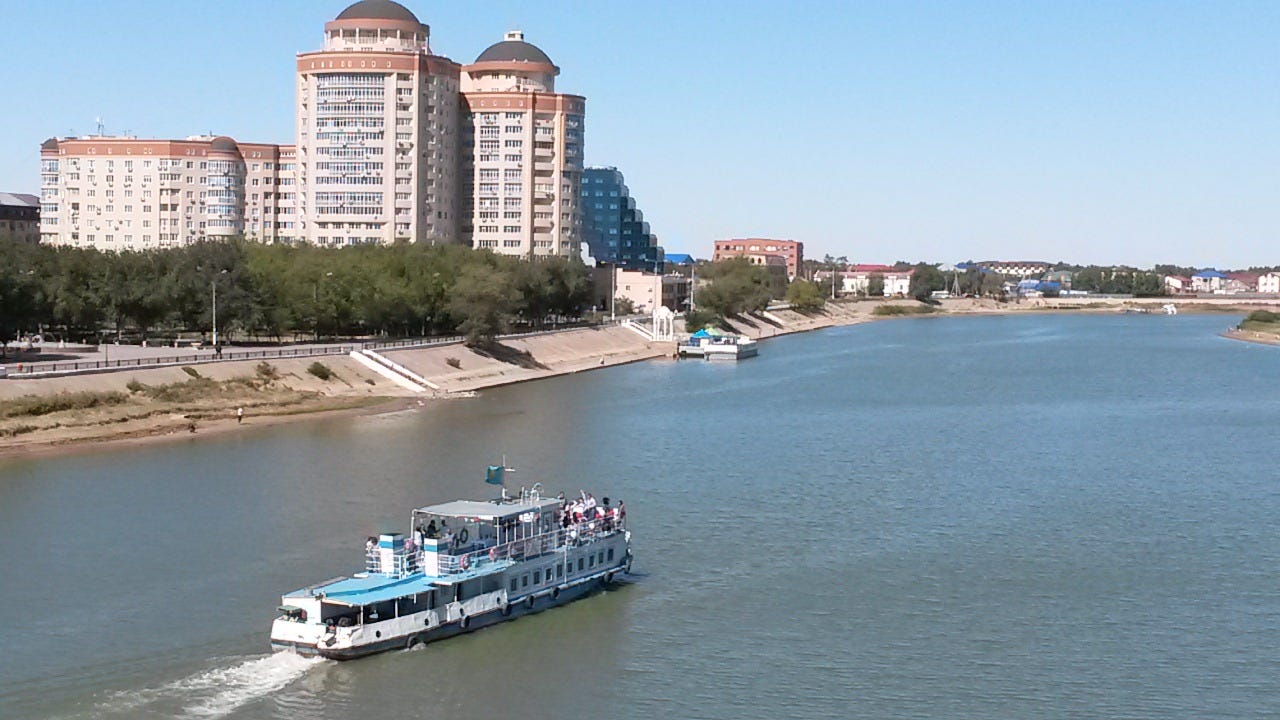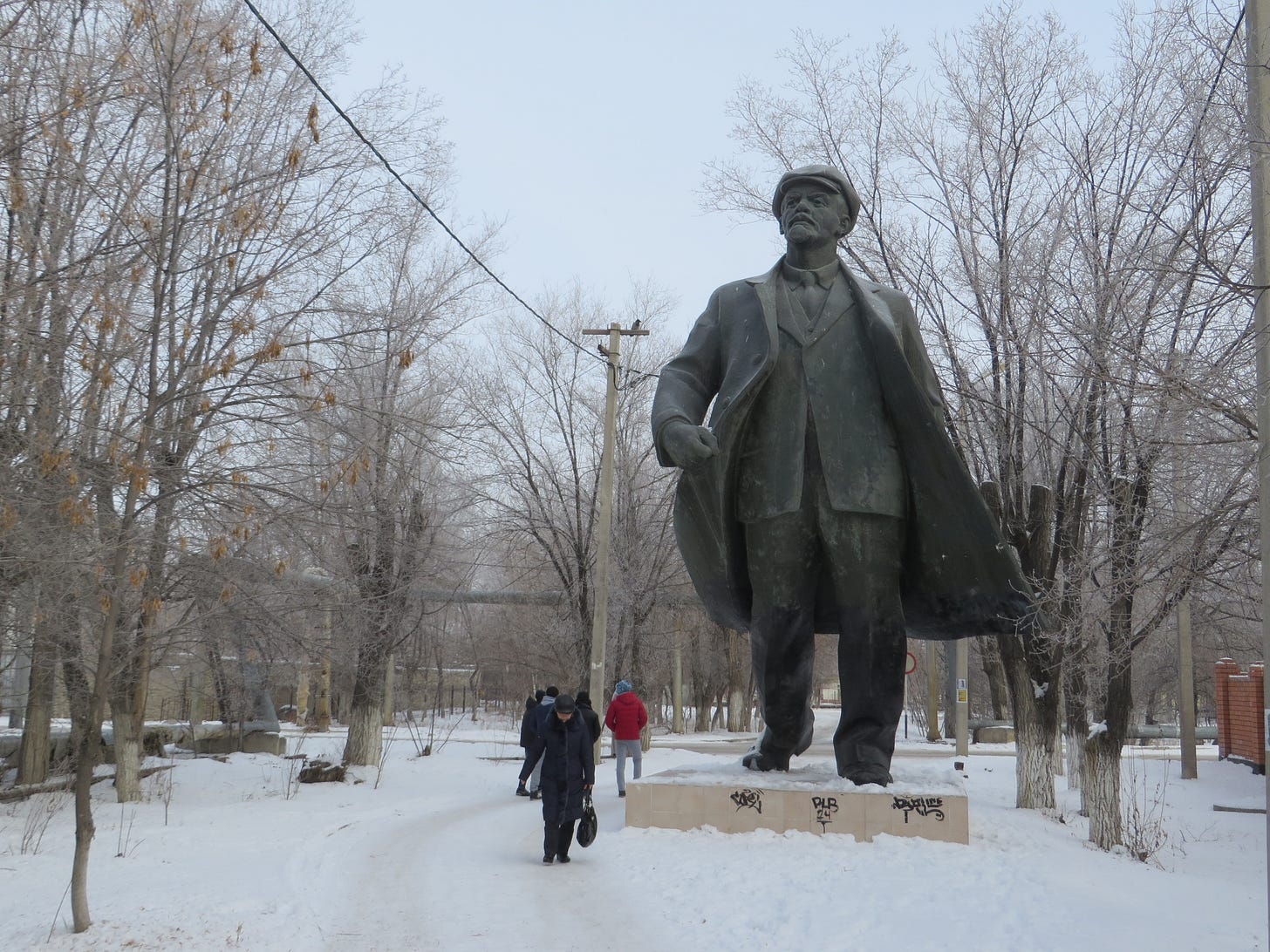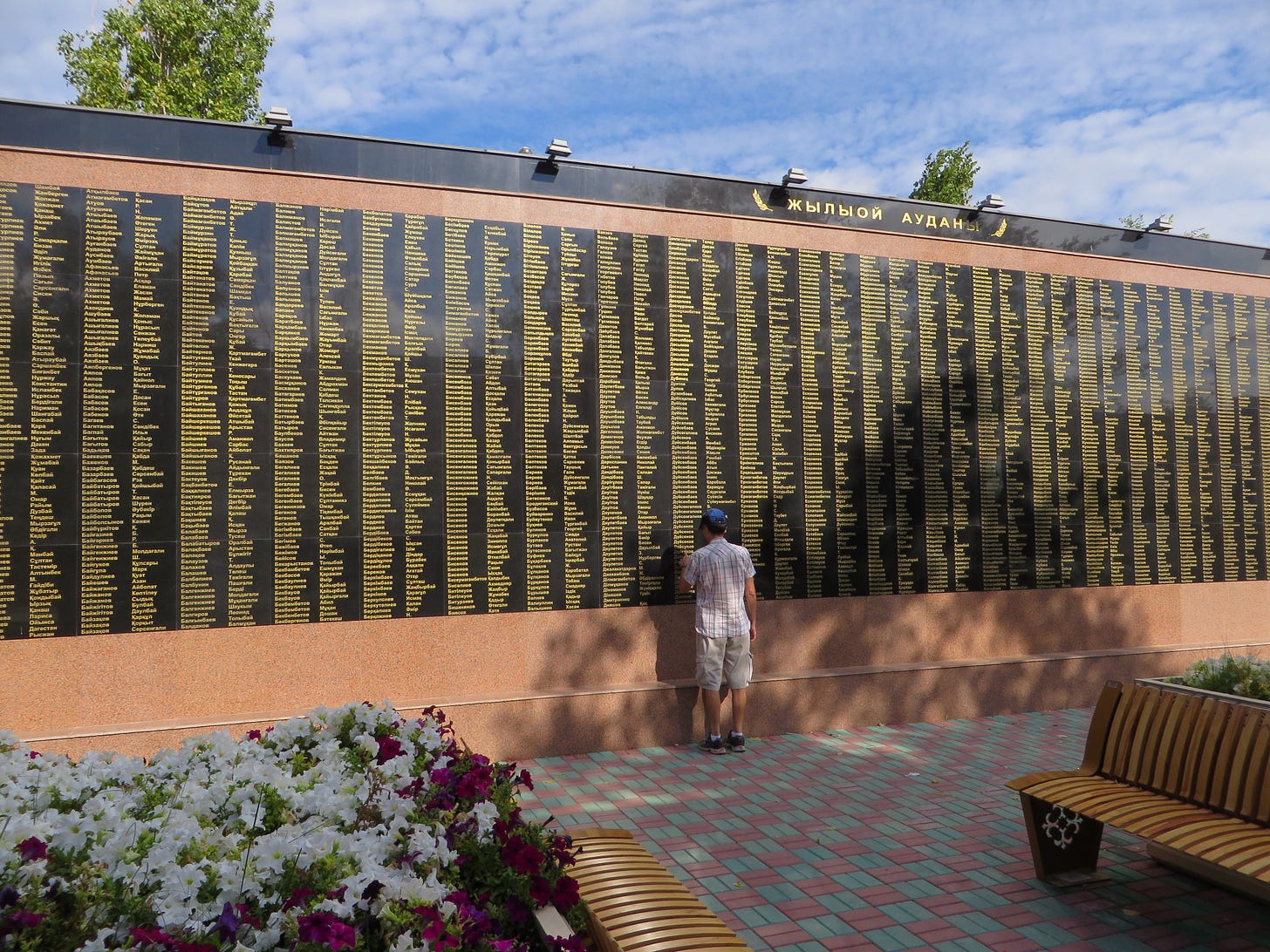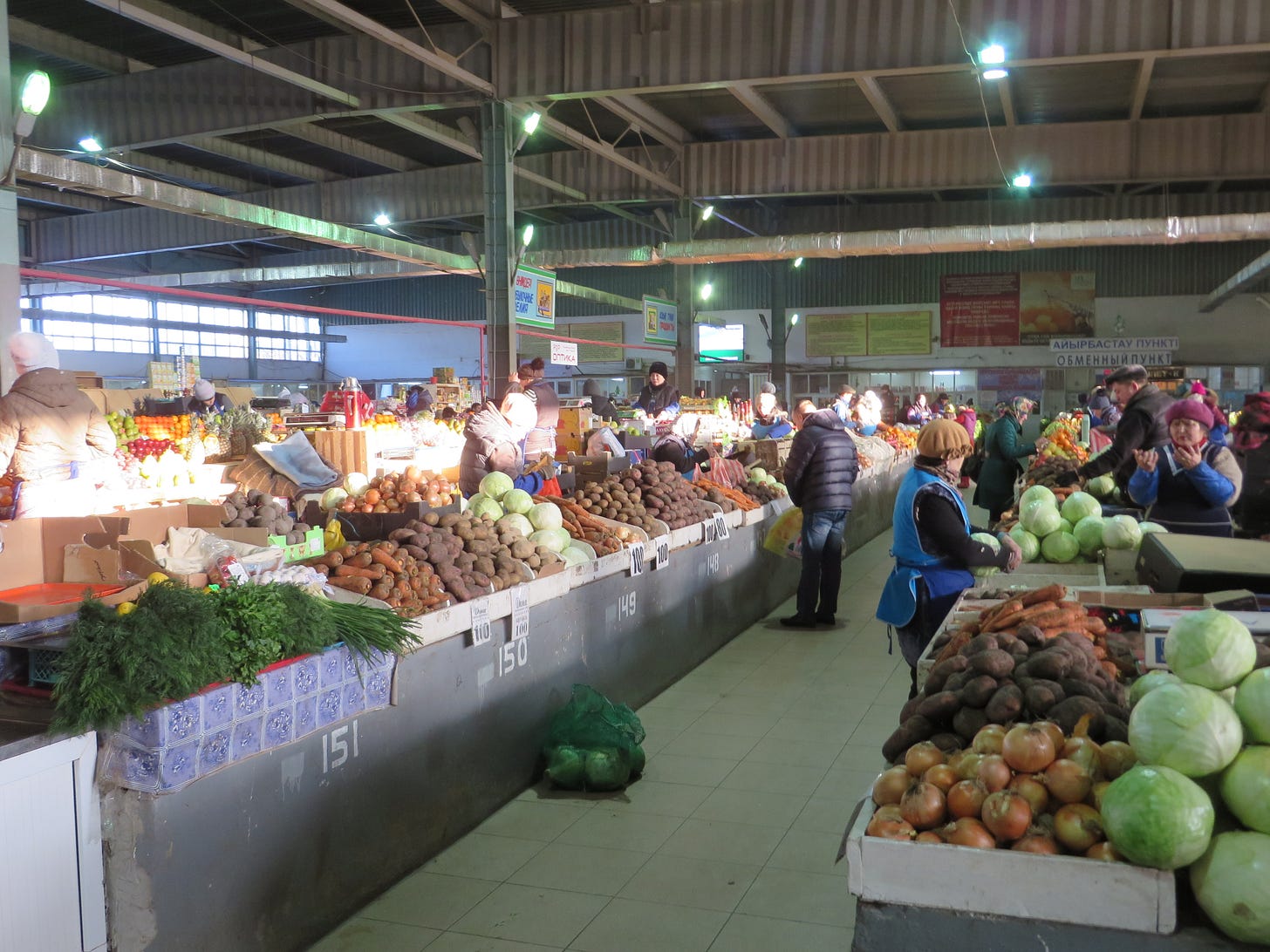Whither Kazakhstan?
The autocratic state trapped between two even more autocratic, expansionist giants
If you think it’s tough being Ukraine, Moldova, Lithuania, Taiwan, Greenland, Canada or Panama right now -- eyed by expansionist, authoritarian regimes -- take a moment to consider the plight of Kazakhstan, sandwiched between not one, but two, of the world’s most oppressive and expansionist dictatorships.
Far More Than Just Borat
If you know one thing about Kazakhstan, it’s probably Borat, the satirical mockumentary movie starring Sacha Baron Cohen as a fictional Kazakh journalist who travels to the United States to learn about American culture. The film was so offensive to Kazakhs that it was banned when I lived and worked there.
Culturally, you might have heard of kokpar, a traditional Central Asian equestrian sport, often described as "horse rugby," where two teams of riders on horseback compete to grab and carry a goat carcass and throw it into designated goals. Originating from nomadic traditions, it demands exceptional horsemanship, strength, and strategy as players fiercely contest possession of the heavy object while maneuvering at high speeds across a large field.
If you’re an aficionado of ethnic food, you might have tried the Kazakh national dish, beshbarmak, translated as "five fingers" because nomads traditionally ate the dish with their hands. Beshbarmak is usually made from finely-chopped, boiled horse meat, mixed with egg noodles and chyk, an onion sauce. It is typically served on large communal platters, shared between several people.
If you’re of a certain age and politically aware, you might be aware of Kazakhstan as a traditional Soviet dumping ground, from political exiles (hello, Leon Trotsky) to nuclear waste. You may have heard about how Kazakhstan was the focus of Soviet First Secretary Nikita Khrushchev’s “Virgin Lands” experiment to greatly increase grain production, and the resulting environmental catastrophes all of these caused.
What You Probably DON’T Know About Kazakhstan
The word "Kazakh" means "free spirit" or "wanderer," reflecting the traditional nomadic lifestyle of the Kazakh people.
Kazakhstan is the ninth-largest country in the world and the largest landlocked country, stretching across both Europe and Asia.
It shares the second-longest continuous land border in the world with Russia, stretching over 7,600 kilometers (the Canada-US border is the longest).
The ancient Silk Road passed through present-day Kazakhstan, and cities like Turkestan were important trading hubs.
It's a multicultural country with over 130 ethnic groups, including Kazakhs, Russians, Uzbeks, Ukrainians, and Germans.
Kazakhstan was a Soviet republic from 1936 until its independence in 1991.
The first domestication of horses by humans occurred in the territory of modern-day Kazakhstan over 5,500 years ago.
Wild apples native to Kazakhstan were the ancestors of all modern apples.
Kazakhstan is rich in natural resources, including oil, gas, uranium, and various minerals.
The vast majority of the world’s space flights originate in Baikonur, the world's first and largest operational space launch facility. Yuri Gagarin's historic first human spaceflight was launched from here. The Baikonur Cosmodrome is still to this day leased to Russia.
While officially secular, the majority of the population identifies as Muslim, with a significant Christian minority.
A Critical Supplier of World Resources
Kazakhstan has the second-largest uranium reserves, which is crucial for nuclear power. It is the world's single largest producer, accounting for up to 41% of global output.
Kazakhstan has substantial supplies of hydrocarbons. It is in the top 15-20 of oil-producing countries, and tenth globally in terms of gas reserves.
Kazakhstan possesses the largest explored reserves of chromium in the world, accounting for approximately 30% of global reserves.
Kazakhstan holds approximately 5% of the global zinc market share in exports and ranks seventh in terms of zinc reserves.
Kazakhstan has the third-largest silver reserves globally.
Kazakhstan ranks third globally in titanium production and holds significant titanium reserves (around 8.7% of world reserves). Titanium is essential for aerospace and other high-tech industries.
Kazakhstan holds the eleventh-largest bauxite (essential for aluminum production) reserves worldwide.
Kazakhstan ranks second globally in manganese ore reserves.
Kazakhstan holds the eighth-largest iron ore reserves in the world.
Kazakhstan possesses very large potash reserves (the world’s single most vital plant fertiliser), over 8 billion tons, estimated to be among the largest in the world.
Kazakhstan has significant potential in rare earth metals. Estimated potential reserves are very high.
A Country with its Own Lengthy History of Strong Authoritarianism
Before Genghis Khan's arrival, the territory of Kazakhstan was home to various nomadic and semi-nomadic groups and early Turkic empires. These societies were often organized in hierarchical structures with strong leaders, with power concentrated in the hands of the ruling clan or dynasty. Decisions regarding war, diplomacy, and resource allocation were largely made entirely by these leaders and their close advisors.
History’s Greatest Conqueror, Genghis Khan
The 13th century arrival of Genghis Khan and the Kazakh territories into the world’s largest ever contiguous land empire in history imposed an even more centralized and absolute form of authoritarian rule.
Shynghyskhan’s (as he is known in Kazakhstan, where many males are still named after him) authority was absolute and divinely sanctioned, stemming from his claim of a mandate from the Eternal Sky. All power was concentrated in his hands. He held supreme authority over military, political, legal, and religious matters. His word was literally law.
Yassa, the Mongol legal code, was enforced with extreme severity and without regard for individual rights. It emphasized collective responsibility and swift, often brutal, punishment for transgressions. Individual freedoms were absent.
As the Mongol Empire fragmented into various khanates in the 15th century, the level of centralized control over distant territories like Kazakhstan weakened. It evolved into the Kazakh Khanate (1465 - 1847), fragmented into three Zhuzes (hordes) (early 18th century), came under Russian influence and gradual incorporation (18th - mid-19th century), became part of Russian Turkestan (mid-19th century - 1917), had a brief period of autonomy (1917-1920) following the 1917 Russian Revolution, then was formally incorporated into the USSR. When the USSR collapsed in 1991, Kazakhstan was the last former Soviet republic to declare independence, only after every other republic already had -- including Russia itself -- showing how closely its Russo-Soviet ties were embedded.
Kazakhstan’s Russo-Soviet Legacy
The relationship between Kazakhstan and the USSR was complex and often brutal, marked by periods of forced integration, exploitation, and extreme suffering for the Kazakh people. It continues to have a profound influence on Kazakhstan, including in trying to free itself from its authoritarian legacy.
Early Soviet Period and Forced Integration
By the mid-1920s, the Bolsheviks had forcibly brought Kazakhstan under Soviet control. Many Kazakhs fled to China and other neighboring countries to escape the new regime. Land reforms often dispossessed nomadic Kazakhs in favor of Russian and other settlers, disrupting their traditional way of life.
The Soviet policy of forced collectivization aimed to settle the nomadic Kazakh population onto collective farms. This radical disruption of their traditional nomadic lifestyle led to widespread chaos and inefficiency in food production.
The Soviet state confiscated vast numbers of livestock from Kazakh herders, often sending them to Moscow while leaving the local population to starve. This removal of their primary means of sustenance was a key factor in a subsequent famine.
Political Repression and Purges
In the late 1920s and 1930s, under Stalin, many Kazakh intellectuals and leaders who had supported autonomy or were deemed "nationalists" were executed or sent to labor camps.
Kazakhstan became home to one of the largest Gulag labor camps, KarLag. Millions of political prisoners from across the Soviet Union, including Kazakhs, were sent there, enduring brutal conditions and high mortality rates.
World War II and its Aftermath
Kazakhstan was integrated into the Soviet war effort, with over a million Kazakhs mobilized into the Red Army. The republic's economy was geared towards supplying the front with essential resources like copper, lead, and other metals.
During and after WWII, various ethnic groups deemed "unreliable" by Stalin, such as Koreans, Volga Germans, Crimean Tatars, and others, were forcibly deported to Kazakhstan. This significantly altered the republic's demographic makeup.
The Virgin Lands Campaign
In the 1950s and 1960s, Khrushchev's Virgin Lands campaign encouraged large-scale migration of Russians and Ukrainians to northern Kazakhstan to cultivate previously unused land. This further shifted the ethnic balance, with non-Kazakhs outnumbering Kazakhs for a significant period.
Limited Political Power for Kazakhs
Throughout much of the Soviet “Russification” period, Russian language and culture were promoted, often at the expense of Kazakh language and traditions. While some Kazakhs held visible political positions, real power often remained in the hands of Russian officials sent from Moscow, particularly in key industrial and governmental sectors.
Environmental Exploitation
The Soviet Union's large-scale irrigation projects, particularly for cotton cultivation, led to the catastrophic drying up of the Aral Sea, causing immense environmental and socio-economic damage to the region.
Kazakhstan was the site of the Semipalatinsk Nuclear Test Site, where hundreds of nuclear weapons were tested by the Soviet Union, causing long-term health and environmental consequences for the local population.
Kazakhstan's Soviet experience was marked by significant hardship, including a devastating famine resulting from forced collectivization, political repression, forced migration, and environmental damage. While there were some aspects of modernization and industrialization, these often came at a tremendous cost to the Kazakh people's traditional way of life, culture, and demographic balance. The legacy of this treatment continues to shape Kazakhstan's national identity and its relationships with Russia and other countries in the post-Soviet era.
The Rise of Kazakh Nationalism
Decades of Soviet rule, with its emphasis on the Russian language and culture, and the influx of other ethnic groups (making Kazakhs a minority in their own country for a time), fostered a latent sense of Kazakh national identity. The suppression of Kazakh history, language, and traditions under the Soviet system created a desire to reclaim and reassert them after independence.
This involved promoting the Kazakh language as the state language, reviving Kazakh culture and history, and emphasizing a distinct Kazakh identity. There was a conscious effort to rewrite history, highlighting pre-Soviet Kazakh figures and events, and re-evaluating the Soviet period as one of occupation and loss.
The promotion of the Kazakh language has been a key aspect of nationalism. While Russian remains widely spoken and influential, there have been ongoing efforts to increase the use and prestige of the Kazakh language in education, government, and public life. This has sometimes led to tensions with the significant Russian-speaking minority. Younger generations, who did not experience the Soviet era directly, often express stronger nationalist sentiments and a desire for a more assertive Kazakh identity.
I worked in Kazakhstan two different times, separated by a year apart. It was striking to see how much social change occurred in such a short time. There was a significant rise in Kazakh patriotism, overt Muslim revival, and rising antagonism towards Russian, Chinese and Western expats, who were not only thought to be taking local jobs but being paid much more for doing them.
The Resurgence of Islamic Belief
The Soviet Union actively suppressed religious practice. With the collapse of communism, there was a significant religious revival across Central Asia, including Kazakhstan. Islam, the traditional religion of the Kazakh people, saw a resurgence. For many Kazakhs, Islam is intertwined with their cultural and national identity. The revival of Islamic practices and traditions has become a way to reconnect with their pre-Soviet heritage.
The rise of Islam in Kazakhstan has been influenced by connections with other Muslim countries, including funding for mosque construction and educational opportunities in Islamic institutions abroad. While a majority identify as Sunni Muslims of the Hanafi school, there are various levels of religious observance, and the government has been cautious about the rise of more radical interpretations.
The Kazakh government has attempted to maintain a secular state while acknowledging the importance of Islam to the cultural identity of the majority. This has involved managing religious expression and preventing the encroachment of religion into the political sphere. While distinct, Kazakh nationalism and the rise of Islam can sometimes intersect. For some, Islam is seen as a key component of Kazakh identity, differentiating it from its historically Orthodox Russian neighbor.
Russia’s cultural legacy is shown in the plethora of vodka choices in stores everywhere, despite the Muslim prohibition on alcohol consumption. Alcoholism was such a problem that sales were cut off after 10 pm when I lived there.
Personalized Authoritarianism
The Nazarbayev Era (1991-2019)
Nursultan Nazarbayev, who was already the leader of the Kazakh SSR when the Soviet Union collapsed, led the country from its independence from the Soviet Union and consolidated significant power into his own hands. He cultivated a personality cult and established a system where his authority was paramount. Key decisions were made by Nazarbayev and his inner circle, with limited input from other institutions.
While a multi-party system existed on paper, the political landscape was tightly controlled.
Opposition parties faced significant obstacles, including harassment, restrictions on their activities, and limited media access.
Elections were often criticized for irregularities and a lack of genuine competition.
The judiciary was not fully independent and was susceptible to political influence.
Corruption was rampant, undermining the rule of law and hindering fair competition.
The government exercised control over the media, limiting freedom of expression.
Protests and public demonstrations were often restricted or suppressed.
Nazarbayev oversaw constitutional amendments that further strengthened the presidency and extended his term in office.
Kazakhstan developed a political system where the president had extensive powers, far exceeding those of a typical presidential republic.
After Nazarbayev (2019-Present)
Transition and Continued Authoritarianism
Nazarbayev's resignation in 2019 and the subsequent election of Kassym-Jomart Tokayev were initially presented as a transition. Tokayev engaged in what he has called political reforms; however, these reforms were viewed by many outside observers as ways of consolidating his own power.
The removal of Nazarbayev's family and allies from key positions.
While some limited political reforms have been implemented, restrictions on freedom of speech, assembly, and political opposition persist.
Challenges remain in ensuring a genuinely independent judiciary and combating corruption.
Though more political actors are involved, the political environment remains tightly controlled by the ruling party.
The January 2022 Protests
The violent suppression of the January 2022 protests raised concerns about the government's willingness to use force to maintain control.
In January 2022, Kazakhstan experienced widespread protests initially sparked by a sharp increase in fuel prices. The protests quickly escalated, and involved broader grievances against the government, corruption, and inequality.
As the situation deteriorated and government buildings were stormed, Tokayev made a formal request for assistance to the Collective Security Treaty Organization (CSTO). The CSTO is a military alliance comprising Russia, Armenia, Belarus, Kyrgyzstan, Tajikistan, and Kazakhstan.
CSTO is an analog of the NATO alliance and its Article 5 requirement that all member nations come to the aid of all others in the case of attack. Tokayev characterized the unrest as an act of external aggression by "terrorist groups" who had allegedly received training abroad (they weren’t, and they hadn’t). He argued that the situation posed a threat to the country's sovereignty and security, requiring external intervention to stabilize it.
In response to Tokayev's request, the CSTO agreed to deploy a "peacekeeping force" to Kazakhstan. The majority of these troops were Russian, with smaller contingents from other member states. The stated aim of the CSTO mission was to protect key strategic facilities and government buildings, allowing Kazakh law enforcement to focus on quelling the protests.
While the Kazakh government presented it as a necessary measure to counter a terrorist threat, many observers viewed it as Russia bolstering its influence in Kazakhstan and supporting Tokayev's government in suppressing dissent.
The CSTO forces withdrew from Kazakhstan shortly after order was restored, fulfilling the Kazakh government's initial request. However, the event highlighted Kazakhstan's security dependence on Russia and the dynamics of power within the post-Soviet space. Russian influence in contemporary Kazakhstan remains substantial.
Language
Kazakhstan is officially a bilingual country. Kazakh is the "state language," spoken fluently by around 80.1% of the population (2021 census). Russian, however, holds the status of "official language" and is widely used in business, government, and inter-ethnic communication. Approximately 83.7% of the population reported proficiency in Russian. Despite the high proficiency, daily usage of Kazakh is lower, with only 63.45% of ethnic Kazakhs and 49.3% of the country's total population using it daily. Russian remains the primary language of communication for many, especially in urban areas. A significant portion of media and higher education programs are still conducted in Russian.

When I worked in Kazakhstan, one of my duties was to mentor and train young, local graduates to do the types of job I was being paid to do. One of them — Kazakh in nationality and heritage, locally educated — inexplicably claimed not to be able to understand the Kazakh language beyond the basics.
Demographics
As of 2025, ethnic Russians constitute a substantial minority of around 14.6% of Kazakhstan's population, numbering approximately 2.96 million people. The Russian population is largely concentrated in the northern, north-western, and north-eastern regions of Kazakhstan, bordering Russia.
This constitutes a clear threat of Russian invasion to “protect” “their” people, as they say they are doing in the Ukrainian territories of Donetsk, Luhansk, Zaporizhzhia and Kherson. Such “protection” of ethnic enclaves is a go-to play of expansionist, authoritarian states. Just ask the people of Austria, the Czechoslovakian Sudetenland, Lithuania’s Memel Territory, Poland’s Danzig and Belgium’s Eupen-Malmedy when Hitler came to “protect” and “liberate” them.
Stuck Between Two Acquisitive Giants: Russia and China
Russia: the Traditional Exploiter
Even after Kazakhstan’s independence in 1991, Russia has not renounced its claims to the country. Boris Yeltsin, Russia’s first President when Russia took over the Soviet Union’s mantle, reserved the right to raise question of revisionist boundaries in Abkhazia, Donbas, Crimea and Kazakhstan. The first was invaded by Russia in 2008, the second and third in 2014.
And Kazakhstan? Kazakhstan rests on the knife edge. In 2014, Russian President Vladimir Putin, “praised” Nazarbayev for creating
"a state on territory where no state had ever existed. The Kazakhs had never had statehood. He [Nazarbayev] created it. In this sense, he is a unique person for the former Soviet space and for Kazakhstan too."
Sound familiar? It certainly would to any Ukrainian reading this.
The remarks were made by Putin in August 2014 during a meeting with university students and young professors at a pro-Kremlin youth camp at Lake Seliger near Moscow. The context of the statement was a discussion about Kazakhstan's post-Nazarbayev future and concerns about potential instability.
The remarks were seen by many in Kazakhstan as a dismissal of their country's historical existence and a challenge to its sovereignty. Kazakh historians and nationalists pointed to the existence of the Kazakh Khanate and other historical forms of Kazakh statehood, contradicting Putin's assertion. The timing of the statement, following Russia's annexation of Crimea, raised concerns about potential Russian irredentism in northern Kazakhstan, which has a significant ethnic Russian population.
Trade
Russia remains one of Kazakhstan's most important trading partners. Bilateral trade turnover between the two is $28 billion USD annually. In 2023, Russian exports to Kazakhstan amounted to $16.1 billion USD, ranking Russia as Kazakhstan's 4th largest export partner globally.
Key exports include refined petroleum, machinery, and iron/steel products. Kazakhstan's exports to Russia were $9.78 billion USD, making Russia its 3rd largest export destination. Top exports include radioactive chemicals, iron/steel, and machinery. Within the Eurasian Economic Union (EAEU), Russia accounts for the vast majority (91.1% as of late 2023) of Kazakhstan's trade with member states.
Despite Kazakhstan's efforts to strengthen its national identity and diversify its foreign relations, Russia maintains significant influence in the country. This influence is evident in the widespread use of the Russian language, the substantial Russian minority population, and the strong economic interdependence, particularly in trade and transportation infrastructure. The historical ties and geographic proximity contribute to this enduring influence, creating a complex balancing act for Kazakhstan as it navigates its relationships with both Russia and China.
China Reasserts Itself (Pick Your Favourite Authoritarian Foreign Oppressor)
Kazakhstan not only shares a 7,600 km land border with Russia, it has a 1,783 km border with China.
As China rose from its century of humiliation (1839–1942, a period of blatant foreign intervention, annexation, and subjugation by Western powers, Russia, and Japan), and pulled itself up by its own bootstraps to challenge the US for the world’s dominant nation, it has become a significant economic partner for Kazakhstan, and both nations officially support each other's sovereignty and territorial integrity.
But concerns and incidents have arisen that some observers interpret as potential threats to Kazakhstan's sovereignty. Anti-Chinese sentiment exists within segments of Kazakh society, fueled by concerns about land grabs, debt dependence, and the treatment of ethnic Kazakhs along with the Uyghurs in Xinjiang, China.
Chinese media articles have begun questioning Kazakhstan's sovereignty over its territory, suggesting historical ties and even implying a desire for Kazakhstan to "return" to China.
(Hello? Hong Kong? Taiwan? Kazakhstan? It’s me, China calling.)
These articles have sparked strong negative reactions and protests in Kazakhstan, with the government going so far as to formally complain to Beijing.
While offering economic opportunities, large-scale Chinese investments under the Belt and Road Initiative (BRI) have raised concerns about Kazakhstan's potential debt burden to China and the long-term implications of this economic reliance. Some worry that this dependence could translate into political leverage for Beijing.
Attempts to increase the duration of land leases to Chinese investors have triggered widespread protests in Kazakhstan due to fears of Chinese economic encroachment and potential loss of land sovereignty. The government has since taken measures to restrict foreign land ownership and leasing due to public pressure.
Rumors in 2019 about plans to relocate numerous Chinese factories to Kazakhstan led to significant Kazakh protests, driven by environmental concerns, fears of job displacement, and anxieties about China's growing industrial footprint.
The situation of ethnic Kazakhs in Xinjiang, China, has also been a sensitive issue. Reports of human rights abuses, including the detention of Kazakhs in so-called “Vocational Education and Training Centers" have caused significant concern and anger in Kazakhstan. While the Kazakh government has been cautious in its public criticism of Beijing due to economic ties, public pressure to address these issues exists.
The Chinese official terminology calling the detention centres “Vocational Education and Training Centers" is widely disputed by the international community, human rights organizations, and former detainees. They describe these facilities as internment camps, re-education camps, or even concentration camps, where Uyghurs and other minorities are subjected to:
Arbitrary detention without due process.
Forced assimilation policies aimed at eroding their cultural and religious identities.
Political indoctrination and forced loyalty to the Chinese Communist Party.
Torture, abuse, and inhumane treatment.
Forced labor.
Restrictions on religious practices, language, and cultural traditions.
The UN Human Rights Office has stated that serious human rights violations have been committed in these facilities and that these actions may constitute crimes against humanity.
There are also ongoing concerns in Kazakhstan about China's use of water from transboundary rivers like the Ili and Irtysh, which originate in China and are vital for Kazakhstan's agriculture and ecology. Some perceive China's upstream water usage as a potential threat to Kazakhstan's environmental and economic security.
These incidents and concerns highlight the underlying tensions and potential risks to Kazakhstan's sovereignty arising from its close relationship with a powerful and increasingly assertive China.
Walking a Tightrope while Carrying Invaluable Cargo
The Weight of Russia's Legacy
Kazakhstan shares a long, complex history with Russia, stemming from well before the Soviet era. This includes significant economic interdependence, particularly in energy and transportation infrastructure. Russian remains a widely spoken language, and cultural ties are strong. This legacy creates a gravitational pull, making a complete pivot away from Russia difficult and potentially costly.
Economic Dependence: Kazakhstan's economy, particularly its energy exports, relies heavily on infrastructure that often transits through Russia (e.g., the Caspian Pipeline Consortium). This gives Russia considerable leverage.
Security Considerations: Kazakhstan is a member of the Russian-led Collective Security Treaty Organization (CSTO). While this provides a security umbrella, it also potentially limits Kazakhstan's independent security policy choices and creates obligations to Russia. The CSTO's intervention during the 2022 unrest highlighted this dynamic.
Enticement and Apprehension Over China's Rise
Economic Opportunities: China's Belt and Road Initiative (BRI) offers significant economic opportunities for Kazakhstan as a crucial transit hub connecting Asia and Europe. China has become Kazakhstan's top trading partner and a major investor, particularly in energy and infrastructure.
Geopolitical Counterweight: China can be seen as a potential counterweight to Russian influence, offering Kazakhstan an alternative partner and market. China has publicly stated its support for Kazakhstan's sovereignty and territorial integrity, which is particularly relevant given Russia's actions in Ukraine.
Concerns about Dependence: However, growing economic reliance on China also brings concerns about potential debt traps, loss of sovereignty, and the influence of Chinese domestic policies (e.g., treatment of Uyghurs) on Kazakhstan's internal affairs. There are public anxieties within Kazakhstan about China's increasing footprint.
The Balancing Act of Multi-Vector Diplomacy
In response to all of these significant challenges, Kazakh government policy is to pursue a multi-vector foreign policy, aiming to balance its relationships with Russia, China, the West, and regional powers like Turkey. This strategy seeks to avoid over-dependence on any single actor and maximize benefits from all.
Navigating Conflicting Interests: The war in Ukraine has severely tested this strategy. Kazakhstan has had to carefully navigate Western sanctions against Russia while trying to maintain economic ties with its northern neighbor and simultaneously deepening engagement with China and the West. This balancing act is becoming increasingly difficult as geopolitical tensions rise.
Seeking Strategic Autonomy: There's a growing understanding within Kazakhstan that it needs to strengthen its own resilience and strategic autonomy to navigate this complex environment. This includes diversifying trade routes, attracting investment from various sources, and potentially strengthening its own security capabilities.
Internal Dynamics and Societal Considerations
Kazakhstan's precarious balancing position between Russia, China and the West is one of constant negotiation and strategic maneuvering. It's a delicate balancing act where the country seeks to leverage the economic opportunities presented by both giants while safeguarding its sovereignty and independence. The war in Ukraine has significantly complicated this situation, forcing Kazakhstan to make increasingly difficult choices and highlighting the inherent risks of its geopolitical location. The success of Kazakhstan's multi-vector diplomacy will depend on its ability to maintain its own agency, diversify its partnerships, and strengthen its internal resilience in the face of immense external pressures.
Kazakh society holds diverse views on relations with Russia and China, influenced by historical ties, economic realities, and nationalist sentiments. The government needs to consider these domestic factors when formulating its foreign policy.
Maintaining internal political stability is crucial for Kazakhstan to effectively manage external pressures from its powerful neighbors. Any internal weakness could be exploited.
However, Kazakhstan still holds many important cards of its own, holding vast natural resources, and retaining its historical position as the old “Silk Road” connecting Asia, Europe and the Middle East. It will be interesting to see how they play them, navigating between two colossi like Russia and China while dealing with its own internal sense of national identity, independence, and rising Muslim sentiment.










